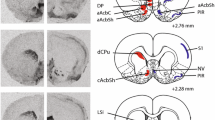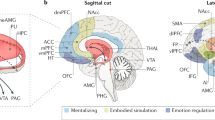Abstract
Like human fathers, male marmosets help raise their young, yet the ways in which fatherhood influences the brain remain largely unknown. We show that first-time and experienced marmoset fathers have enhanced density of dendritic spines on pyramidal neurons in prefrontal cortex as compared to non-fathers. In parallel, the abundance of vasopressin V1a receptors and the proportion of V1a receptor–labeled dendritic spines increase.



Similar content being viewed by others
References
Rylands, A.B. (ed.) Marmosets and Tamarins: Systematics, Behaviour, and Ecology (Oxford University Press, Oxford, UK, 1993).
Leibenluft, E., Gobbini, M.I., Harrison, T. & Haxby, J.V. Biol. Psychiatry 56, 225–232 (2004).
Nitschke, J.B. et al. Neuroimage 21, 583–592 (2004).
Radley, J. et al. Exp. Neurol. 196, 199–203 (2005).
Kozorovitskiy, Y. et al. Proc. Natl. Acad. Sci. USA 102, 17478–17482 (2005).
Wynne-Edwards, K.E. Horm. Behav. 40, 139–145 (2001).
Roky, R. et al. Neuroendocrinology 63, 422–429 (1996).
Smeltzer, M.D., Curtis, J.T., Aragona, B.J. & Wang, Z. Neurosci. Lett. 394, 146–151 (2006).
Peden, J.K. & von Bonin, G. J. Comp. Neurol. 86, 37–63 (1974).
Wang, Z. et al. Brain Res. 768, 147–156 (1997).
Son, M.C. & Brinton, R.D. Neurobiol. Learn. Mem. 76, 388–402 (2001).
Engert, F. & Bonhoeffer, T. Nature 399, 66–70 (1999).
Kritzer, M.F. & Goldman-Rakic, P.S. J. Comp. Neurol. 359, 131–143 (1995).
Acknowledgements
We thank C. Gross, A. Pavlic, B. Leuner, C. Mirescu, M. McBreen and J. Goodhouse for their help. This work was supported by the US National Institutes of Health and National Alliance for Research on Schizophrenia and Depression, the Mental Health Research Association (E.G.), and a National Research Service Award fellowship (Y.K).
Author information
Authors and Affiliations
Corresponding author
Ethics declarations
Competing interests
The authors declare no competing financial interests.
Supplementary information
Supplementary Table 1
Fatherhood does not affect dendritic spine density, length and branching on occipital cortex pyramidal cells. (PDF 71 kb)
Supplementary Table 2
Fatherhood does not affect dendritic length and branching on prefrontal cortex pyramidal cells. (PDF 67 kb)
Supplementary Table 3
Fatherhood does not affect optical intensity of vasopressin V1a receptors in of the OC or vasopressin V1b, prolactin and oxytocin receptors in the PFC. (PDF 62 kb)
Rights and permissions
About this article
Cite this article
Kozorovitskiy, Y., Hughes, M., Lee, K. et al. Fatherhood affects dendritic spines and vasopressin V1a receptors in the primate prefrontal cortex. Nat Neurosci 9, 1094–1095 (2006). https://doi.org/10.1038/nn1753
Received:
Accepted:
Published:
Issue Date:
DOI: https://doi.org/10.1038/nn1753
- Springer Nature America, Inc.
This article is cited by
-
The neural mechanisms and consequences of paternal caregiving
Nature Reviews Neuroscience (2019)





